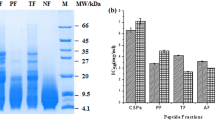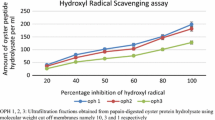Abstract
Silkworm pupae are a kind of insect resource food that rich of good quality protein. To identify the peptide with high antioxidant activity from silkworm pupae protein hydrolysates, and provide the basis for the application of silkworm pupae protein hydrolysates and antioxidant peptides in functional foods, silkworm pupae proteins were hydrolysed by a dual-enzyme system consisting of acidic protease and neutral protease. The hydrolysates were purified sequentially by ultrafiltration, gel filtration chromatography and high-performance liquid chromatography (HPLC). The ABTS radical scavenging activity was used to evaluate antioxidant activity. Fractions with high activity were further analyzed by liquid chromatography- tandem mass spectrometry (LC–MS/MS). Two peptides, FKGPACA and SVLGTGC with molecular weights of 692.34 and 635.30 Da were obtained. To further determine the major active sites of FKGPACA and SVLGTGC, four peptides, FKGP, ACA, SVLG and TGC were artificially synthesized. ACA and TGC had higher ABTS radical scavenging activities than FKGP and SVLG. The main active sites of FKGPACA and SVLGTGC were possibly located in the ACA and TGC fragments, which are related to Cys, Ala or Thr residues. Both FKGPACA and SVLGTGC proved to good antioxidants even after high-temperature thermal processing for 1 h. After digestion with pepsin, the ABTS radical scavenging activity of FKGPACA was stable, while the ABTS radical scavenging activity of SVLGTGC decreased slightly. After further digestion with pancreatin, the ABTS radical scavenging activities of FKGPACA and SVLGTGC decreased by 10.59% and 43.56%, respectively. After digestion with chymotrypsin, the ABTS radical scavenging activities of FKGPACA and SVLGTGC were stable. The silkworm pupae protein hydrolysates and FKGPACA could be potentially used as natural antioxidants in functional foods.






Similar content being viewed by others
References
Hancock JT, Desikan R, Neill SJ (2001) Role of reactive oxygen species in cell signalling pathways. Biochem Soc Trans 29(Pt 2):345–350
Zheng Z, Si D, Ahmad B, Li Z, Zhang R (2018) A novel antioxidative peptide derived from chicken blood corpuscle hydrolysate. Food Res Int 106:410–419
Fontoura R, Daroit DJ, Corrêa APF, Moresco KS, Santi L, Beys-da-Silva WO, Yates JR, Moreira JCF, Brandelli A (2019) Characterization of a novel antioxidant peptide from feather keratin hydrolysates. New Biotechnol 49:71–76
Hu FY, Chi CF, Wang B, Deng SG (2015) Two novel antioxidant peptides from protein hydrolysate of skate (Raja porosa) muscle. Marine Drugs 13:1993–2009
Qian Z, Jung W, Kim S (2008) Free radical scavenging activity of a novel antioxidative peptide purified from hydrolysate of bullfrog skin. Rana catesbeiana Shaw Biore Tech 99(6):1690–1698
Sheih IC, Wu T, Fang TJ (2009) Antioxidant properties of a new antioxidative peptide from algae protein waste hydrolysate in different oxidation systems. Biore Tech 100(13):3419–3425
Archibong AE, Rideout ML, Harris KJ, Ramesh A (2018) Oxidative stress in reproductive toxicology. Curr Opin Toxicol 7:95–101
Jin D, Liu X, Zheng X, Wang X, He J (2016) Preparation of antioxidative corn protein hydrolysates, purification and evaluation of three novel corn antioxidant peptides. Food Chem 204:427–436
Klompong V, Benjakul S, Kantachote D, Shahidi F (2007) Antioxidative activity and functional properties of protein hydrolysate of yellow stripe trevally (Selaroides leptolepis) as influenced by the degree of hydrolysis and enzyme type. Food Chem 102(4):1317–1327
Shazly AB, He Z, El-Aziz MA, Zeng M, Zhang S, Qin F, Chen J (2017) Fractionation and identification of novel antioxidant peptides from buffalo and bovine casein hydrolysates. Food Chem 232:753–762
Wang W, Shen S, Chen Q, Tang B, He G, Ruan H (2008) Hydrolyzates of silkworm pupae (Bombyx mori) protein is a new source of angiotensin 1-converting enzyme inhibitory peptides (ACEIP). Curr Pharm Biotechnol 9:307–314
Yu Z, Yin Y, Zhao W, Liu J, Chen F (2012) Anti-diabetic activity peptides from albumin against α-glucosidase and α-amylase. Food Chem 135(3):2078–2085
Yu W, Field CJ, Wu J (2018) Purification and identification of anti-inflammatory peptides from spent hen muscle proteins hydrolysate. Food Chem 253:101–107
Agrawal H, Joshi R, Gupta M (2016) Isolation, purification and characterization of antioxidative peptide of pearl millet (Pennisetum glaucum) protein hydrolysate. Food Chem 204:365–372
Sarmadi BH, Ismail A (2010) Antioxidative peptides from food proteins: a review. Peptides 31(10):1949–1956
Ahn C, Kim J, Je J (2014) Purification and antioxidant properties of octapeptide from salmon byproduct protein hydrolysate by gastrointestinal digestion. Food Chem 147:78–83
Brandelli A, Daroit DJ, Corrêa APF (2015) Whey as a source of peptides with remarkable biological activities. Food Res Int 73:149–161
Lim S, Choi AH, Kwon M, Joung EJ, Shin T, Lee SJ, Kim NG, Kim HR (2019) Evaluation of antioxidant activities of various solvent extract from Sargassum serratifolium and its major antioxidant components. Food Chem 278:178–184
Yu Z, Yin Y, Zhao W, Yu Y, Liu B, Liu J, Chen F (2011) Novel peptides derived from egg white protein inhibiting alpha-glucosidase. Food Chem 129(4):1376–1382
Tomotake H, Katagiri M, Yamato M (2010) Silkworm pupae (Bombyx mori) are new sources of high quality protein and lipid. J Nutr Sci Vitaminol 56(6):446–448
Zhou J, Han D (2006) Proximate, amino acid and mineral composition of pupae of the silkworm Antheraea pernyi in China. J Food Comp Anal 19(8):850–853
Lee SH, Park D, Yang G, Bae D, Yang Y, Kim TK, Kim D, Kyung J, Yeon S, Koo KC, Lee JY, Hwang SY, Joo SS, Kim YB (2012) Silk and silkworm pupa peptides suppress adipogenesis in preadipocytes and fat accumulation in rats fed a high-fat. Euro J Nutr 51:1011–1019
Wang W, Wang N, Zhou Y, Zhang Y, Xu L, He G (2011) Isolation of a novel peptide from silkworm pupae protein components and interaction characteristics to angiotensin I-converting enzyme. Euro Food Res Technol 232:29–38
Yang R, Zhao X, Kuang Z, Ye M, Luo G, Xiao G, Liao S, Li L, Xiong Z (2013) Optimization of antioxidant peptide production in the hydrolysis of silkworm (Bombyx mori L.) pupa protein using response surface methodology. J Food Agric Environ 2(11):952–956
Jia J, Wu Q, Yan H, Gui Z (2015) Purification and molecular docking study of a novel angiotensin-I converting enzyme (ACE) inhibitory peptide from alcalase hydrolysate of ultrasonic-pretreated silkworm pupa (Bombyx mori) protein. Process Biochem 50(5):876–883
Tao M, Wang C, Liao D, Liu H, Zhao Z, Zhao Z (2017) Purification, modification and inhibition mechanism of angiotensin I-converting enzyme inhibitory peptide from silkworm pupa (Bombyx mori) protein hydrolysate. Process Biochem 54:172–179
Wu Q, Jia J, Hui Y, Du J, Gui Z (2015) A novel angiotensin-I converting enzyme (ACE) inhibitory peptide from gastrointestinal protease hydrolysate of silkworm pupa (Bombyx mori) protein: biochemical characterization and molecular docking study. Peptides 68:17–24
Wang W, Wang N, Zhang Y, Wu X, Xu L, Wang J (2012) Antioxidant activities of silkworm protein hydrolyzates by bi-enzyme. Acta agric Zhejiangensis 24(2):42–46 (in chinese)
Mirzaei M, Mirdamadi S, Ehsani MR, Aminlari M (2018) Production of antioxidant and ACE-inhibitory peptides from Kluyveromyces marxianus protein hydrolysates: purification and molecular docking. J Food Drug Anal 26(2):696–705
Lu X, Zhang L, Sun Q, Song G, Huang J (2019) Extraction, identification and structure-activity relationship of antioxidant peptides from sesame (Sesamum indicum L.) protein hydrolysate. Food Res Int 116:707–716
Yan QZ, Huang LH, Sun Q, Jiang ZQ, Wu X (2015) Isolation, identification and synthesis of four novel antioxidant peptides from rice residue protein hydrolyzed by multiple proteases. Food Chem 179:290–295
Asha KK, Remya Kumari KR, Ashok Kumar K, Chatterjee NS, Anandan R, Mathew S (2016) Sequence determination of an antioxidant peptide obtained by enzymatic hydrolysis of oyster crassostrea madrasensis (Preston). Int J Pept Res Ther 22:421–433
Feng Y, Ruan G, Jin F, Xu J, Wang F (2018) Purification, identification, and synthesis of five novel antioxidant peptides from Chinese chestnut (Castanea mollissima Blume) protein hydrolysates. LWT Food Sci Technol 92:40–46
Wong FC, Xiao J, Ong MGL, Pang MJ, Wong SJ, Teh LK, Chai TT (2019) Identification and characterization of antioxidant peptides from hydrolysate of blue-spotted stingray and their stability against thermal, pH and simulated gastrointestinal digestion treatments. Food Chem 271:614–622
Liu R, Zheng W, Li J, Wang L, Wu H, Wang X, Shi L (2015) Rapid identification of bioactive peptides with antioxidant activity from the enzymatic hydrolysate of Mactra veneriformis by UHPLC–Q-TOF mass spectrometry. Food Chem 167:484–489
Tian M, Fang B, Jiang L, Guo H, Cui J, Ren F (2015) Structure-activity relationship of a series of antioxidant tripeptides derived from β-Lactoglobulin using QSAR modeling. Dairy Sci Technol 95(4):451–463
Zou T, He T, Li H, Tang H, Xia E (2016) The structure-activity relationship of the antioxidant peptides from natural proteins. Molecules 21(1):72
Nalinanon S, BenjakulS KH, Shahidi F (2011) Functionalities and antioxidant properties of protein hydrolysates from the muscle of ornate threadfin bream treated with pepsin from skipjack tuna. Food Chem 124(4):1354–1362
Jang HL, Liceaga AM, Yoon KY (2016) Purification, characterisation and stability of an antioxidant peptide derived from sandfish (Arctoscopus japonicus) protein hydrolysates. J Funct Foods 20:433–442
Ketnawa S, Martínez-Alvarez O, Benjakul S, Rawdkuen S (2016) Gelatin hydrolysates from farmed Giant catfifish skin using alkaline proteases and its antioxidative function of simulated gastro-intestinal digestion. Food Chem 192(Supplement C):34–42
Acknowledgements
This work was supported by the National Natural Science Foundation of China (No. 31401495), Natural Science Foundation of Zhejiang Province (No. LY13C200015), and Key R&D Project of Zhejiang Province (2018C02048).
Author information
Authors and Affiliations
Corresponding author
Ethics declarations
Conflict of interest
The authors declare that they have no conflict of interest.
Compliance with ethics requirements
This article does not contains any studies with human participants or animals performed by any of the authors.
Additional information
Publisher's Note
Springer Nature remains neutral with regard to jurisdictional claims in published maps and institutional affiliations.
Rights and permissions
About this article
Cite this article
Zhang, Y., Wang, J., Zhu, Z. et al. Identification and characterization of two novel antioxidant peptides from silkworm pupae protein hydrolysates. Eur Food Res Technol 247, 343–352 (2021). https://doi.org/10.1007/s00217-020-03626-5
Received:
Revised:
Accepted:
Published:
Issue Date:
DOI: https://doi.org/10.1007/s00217-020-03626-5




